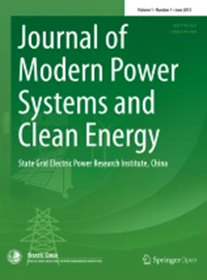Dynamic Modelling, Control, and Stability Analysis of DC Modular Multilevel Converter Connected to HVDC Cables
IF 6.1
1区 工程技术
Q1 ENGINEERING, ELECTRICAL & ELECTRONIC
Journal of Modern Power Systems and Clean Energy
Pub Date : 2024-10-15
DOI:10.35833/MPCE.2023.001004
引用次数: 0
Abstract
Innovative dynamic models for the DC modular multilevel converter (DC-MMC) in rotating与高压直流电缆相连的直流模块化多电平转换器的动态建模、控制和稳定性分析
针对旋转${dq}$框架中的直流模块化多电平变换器(DC- mmc),提出了一种创新的动态模型,以提高变换器的设计和稳定性分析。使用三个${dq}$框架开发开环和闭环模型,详细检查了二阶和三次谐波分量对模型精度的影响。本文的一个新颖贡献是在闭环模型中集成了一个2次谐波电流抑制控制器(SHCSC),为其对系统稳定性的影响提供了新的见解。通过将DC- mmc模型与两侧的高压直流(HVDC)电缆耦合,进一步扩展了DC- mmc模型,形成了一个互连的系统模型,准确地代表了未来直流电网的更真实的场景。通过对PSCAD基准模型的严格验证,验证了该模型的精度和可靠性。然后利用互联系统模型分析了电缆长度对系统稳定性的影响,论证了实际应用。随后将闭环模型用于互联系统的稳定性评估,展示了其在现实场景中的适用性。此外,利用参与因子法和剩余法设计了阻尼控制器,为振动阻尼和稳定性优化提供了一种改进的方法。通过特征值分析评估了控制器的有效性,并辅以仿真结果,强调了其增强系统稳定性的潜力。
本文章由计算机程序翻译,如有差异,请以英文原文为准。
求助全文
约1分钟内获得全文
求助全文
来源期刊

Journal of Modern Power Systems and Clean Energy
ENGINEERING, ELECTRICAL & ELECTRONIC-
CiteScore
12.30
自引率
14.30%
发文量
97
审稿时长
13 weeks
期刊介绍:
Journal of Modern Power Systems and Clean Energy (MPCE), commencing from June, 2013, is a newly established, peer-reviewed and quarterly published journal in English. It is the first international power engineering journal originated in mainland China. MPCE publishes original papers, short letters and review articles in the field of modern power systems with focus on smart grid technology and renewable energy integration, etc.
 求助内容:
求助内容: 应助结果提醒方式:
应助结果提醒方式:


